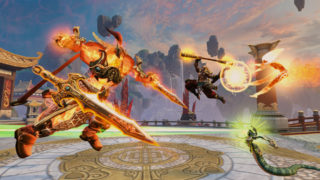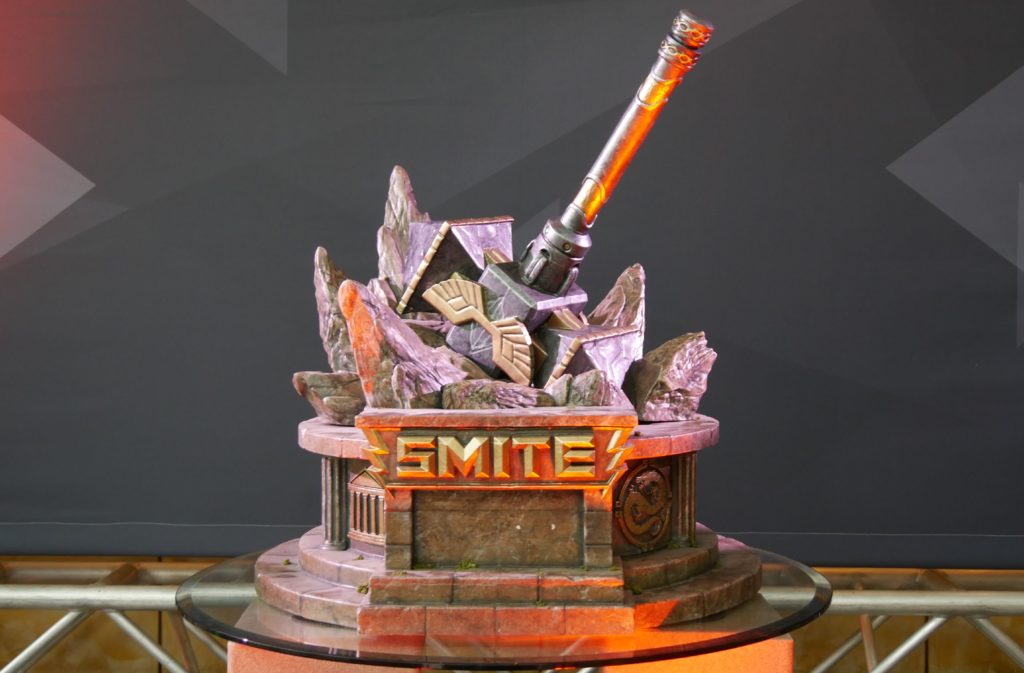Although Hi-Rez Studios is finding great success with games such as Paladins, Smite remains the company’s flagship title. The Hi-Rez Expo held earlier this month was billed as the Smite World Championships in previous years, and fans come from all over the world came and sold out seats at the Cobb Energy Performing Arts Center in Atlanta, Georgia to watch pro teams take each other on in the MOBA game where gods from different pantheons team up to do battle. In fact, the game is so popular that the Hi-Rez Expo showcased two spin-off games, Smite Tactics and Smite Rivals, so that attendees could experience the game in different ways.

Chris Larsen, executive producer for Smite, spoke to [a]listdaily from the Hi-Rez Expo to discuss how the game has grown as an eSport and how greatly the player base has expanded since launching on consoles.
Larsen begins by talking about how new content is released every two weeks in the form of new gods and maps, in addition to how the rules for Conquest (the game’s most popular competitive mode) is changed. Season Four will see even more key changes to Conquest, with new objectives that give more positional advantages. Most notably, The Morrigan was added to the roster this month. She is the first god from the new Celtic pantheon, which will be a major focus of the game this year. However, that doesn’t mean that existing pantheons will be overlooked, as Hi-Rez will continue to expand them.
“More specifically, we’re going to go back to the Hindu pantheon,” said Larsen. “We didn’t release any Hindu gods in the last twelve months, so we’re going to go back and revisit that.”
We asked about how a game that has continually updated rules fits into the world of eSports, considering how traditional sports generally have more constant rules.
Larsen explains: “Obviously, eSports is different from football and soccer. Players expect that—since new gods and abilities are being added on a regular basis—the rules of engagement change. In eSports, changing the map and strategic elements of it adds more excitement, and it gives players something to do during the season changeover: figure out what the new meta is. It’s also good for players coming in for the first time after the season changes. The gaps in strategic knowledge of the game aren’t so big. In February, when we make changes to Conquest mode and add new things to Clash and other maps, new players won’t be at such a disadvantage.”
We asked Larsen if it was difficult for Smite to attract new players, after having been out for over two years, or if the company was putting its focus on existing and pro players. “It’s a balance,” said Larsen. “We have people who used to be in the pro scene who work for us now, and we’re also in tight communication with many of the teams. We take their input about changes to make sure the game is at the highest competitive level possible. At the same time, we have to have more casual elements to the game. We have to cater to people who don’t play Conquest at all. That’s why Smite has a number of different game modes, and some are supposed to funnel the casual audience and new players toward Conquest. For example, the new Clash map we have this year was re-arted to be Egyptian and we fixed some of the objectives that we thought were not helping players learn Conquest. Those things don’t help pro players, but it adds a fresh coat of paint for new or returning players.”
Larsen also discussed an issue that many competitive games face, where experienced players intimidate or drive away new players. “That’s going to be a big focus for this year,” he said. “Bad manners will always happen in the game, but we’re going to introduce something called team consumables. In the match lobby, you have a limited quantity of things that help the entire team, which are purchased using in-game supplies. If you’re someone who gives that team bonus, the chances of your team lashing out at you during a match may be lower. The other avenue is matchmaking and making sure that you’re with players that are of equal skill level. But we’re looking at other things, like the player reporting system. Last year, we added a feature where, if you reported someone that we suspended or took action on, you got a notification that thanked you for reporting the misbehavior. We don’t mention specific names or actions, but it’s usually enough to show players that their voices do matter.”
When asked about how Smite engages with its growing audience, Larsen said that it was primarily through social media. “We’re very active on Reddit, but not so much on Facebook—although the marketing team does interact on Facebook. We’re mostly Twitter, Reddit and our own forums.”
So, what is the key to growing a game as an eSport, compared to a traditional competitive game? “Prize money?” Larsen said jokingly. “For MOBAs, it’s just a shoo-in. Games like Dota 2 and League of Legends have forged the path to making MOBAs eSports games, and people like to watch them. For us, it’s also about structuring our LAN tournaments so that there’s a healthy new population of players that can grow into the game and get into the pro scene. The Challenger Cup is a very important avenue for nurturing new players and competitors into something that might be able to challenge the pro teams later on. We’ve seen a lot of people—entire teams—come up from the Challenger Cup. If they win there, they automatically get a spot to play against the pros, then they’re in the pro scene.
“The other avenue is—and this has happened more than once in Smite—ranked play in our league system. Ranked play is a small community, making up between three to five percent of the population, but you get a lot of visibility. You start playing against the best players through matchmaking, so they get to know each other through that indirect exposure and teams recruit from people doing well in ranked.”
With the inclusion of The Morrigan, there are 84 gods featured in Smite. We asked Larsen about when Hi-Rez would consider slowing down the introduction of new characters. “I think at some point, you ramp down the production of gods and start focusing on other things,” he said. “But our cadence is releasing a new god once a month, and we still feel that that’s an appropriate amount of effort. At some point, we might decide to pull back on that, but for now, I think we can still continue on to that magic 100 number and see where we’re at then.”
 Larsen also discussed how Smite has grown on consoles since its release on Xbox One in 2015 and the PlayStation 4 launch last year. “I’m really excited for 2017 because all platforms have been rolled out,” said Larsen. “The growth has been phenomenal. We have as many players on one of the console platforms as we do on the PC, so our player base has doubled. Smite fit easily into console play. League of Legends couldn’t launch an exact copy on consoles because the controls wouldn’t work. But Smite has a third-person perspective, and those that play games like Destiny are already familiar with it, so the game fit tightly in that environment.”
Larsen also discussed how Smite has grown on consoles since its release on Xbox One in 2015 and the PlayStation 4 launch last year. “I’m really excited for 2017 because all platforms have been rolled out,” said Larsen. “The growth has been phenomenal. We have as many players on one of the console platforms as we do on the PC, so our player base has doubled. Smite fit easily into console play. League of Legends couldn’t launch an exact copy on consoles because the controls wouldn’t work. But Smite has a third-person perspective, and those that play games like Destiny are already familiar with it, so the game fit tightly in that environment.”
Larsen also stated that console players had a kind of hunger for the MOBA experience to come to their platforms. “When we launched on consoles, a lot of people said, ‘finally, we have Smite on Xbox.’ Smite was out for so long before coming to consoles, that there was a lot of knowledge about the game, even for people who didn’t play.”
However, there was some initial concerns regarding the console launch. “We were kind of nervous at first,” admitted Larsen, “thinking that players who owned both an Xbox One and a PC might migrate to the console and pull away from the PC population. I think it did in the first couple of months, but that was a very small percentage of people. Now console players see their friends on consoles, and new players come from that environment—they don’t get sucked in from the PC. We have seen some people go to console then return to PC.”
So, what is it about Smite that appeals to so many people across different platforms, leading to the launch of two spin-off games? “A lot of people are into the lore and mythology of Smite,” Larsen said. “The character development that we’ve done has spurred on interest in other people’s cultures and pantheons. Bringing those elements to different games with a different context has just been very straightforward, and people have been very excited about it. It’s an IP that we want to extend to other things. Tactics, which is a strategic card/board game has been great, and Rivals—which is more of a casual mobile game—is another avenue where we can take things that we’ve worked on for many years and translate it into a different context.”
Learn everything you need to know to invest in today’s fastest-growing media channel—Competitive Gaming and eSports on 2.16.17 in Los Angeles. Go to alistsummit.com for more info.

